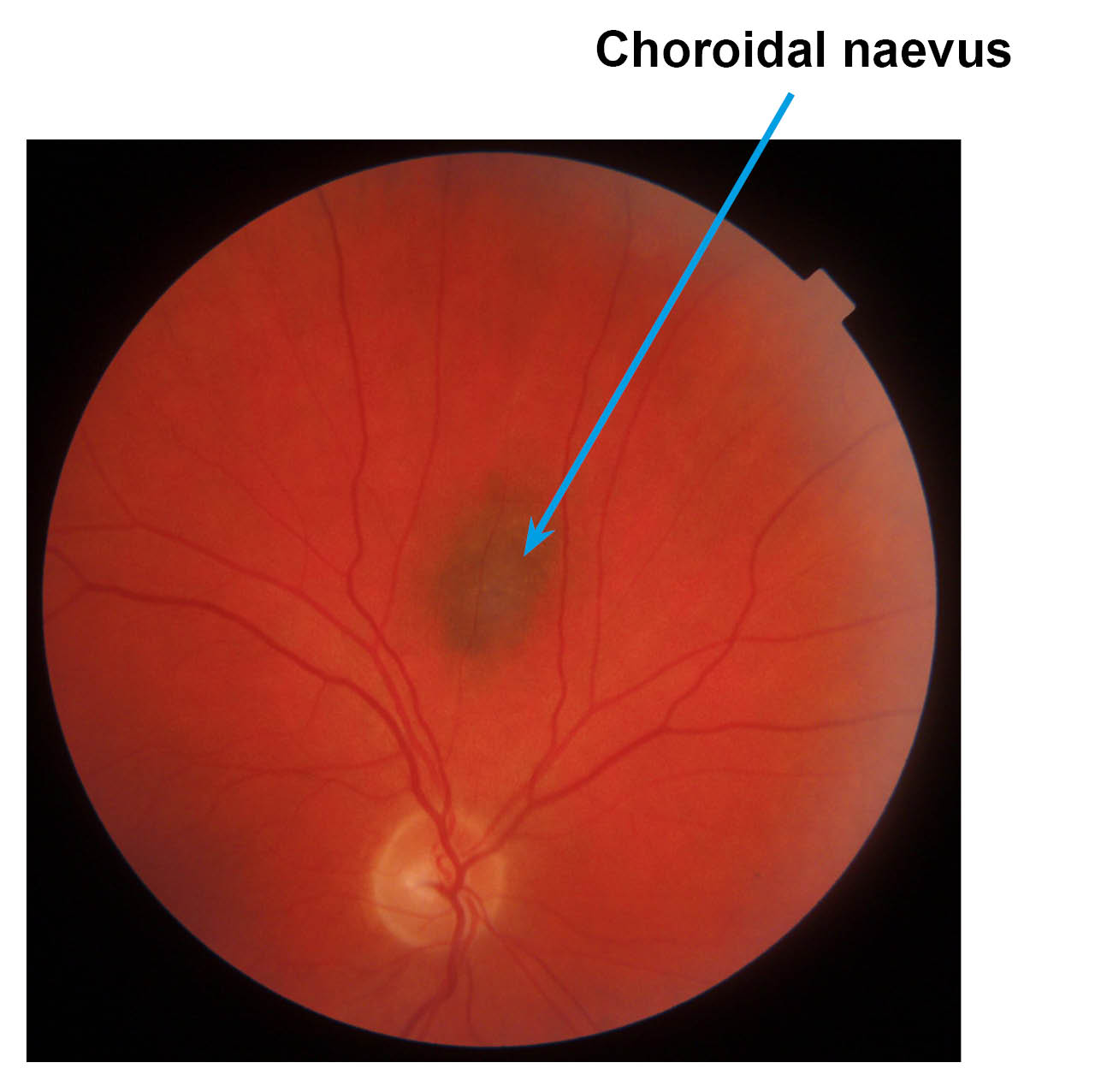Naevus Imaging Clinic
Information for patients from Ophthalmology
You have been diagnosed with a choroidal naevus, and referred to the Naevus Imaging Clinic. This leaflet will:
explain what a choroidal naevus is
what the treatment options are, and
what will happen during and after your appointment.
If you have any questions after reading this leaflet, please speak to the ophthalmic technician at your appointment.
What is a choroidal naevus?

A choroidal naevus is a pigmented (darkly coloured) patch seen on the retina at the back of the eye. It is similar to a skin naevus (mole) that can be found on other parts of the body. Just like in the skin, the eyes contain cells which produce pigment and these cells can cause a mole to develop inside the eye.
What are the symptoms?
There are no symptoms. Naevus are present in about 5 in every 100 members of the general population. They are usually found during an eye examination for another eye problem at your opticians or at the ophthalmic department.
Do I need treatment?
Like any mole, there is a slight risk (1 in 8,845 cases) of it becoming a malignant (cancerous) lesion known as Choroidal Malignant Melanoma (CMM), so it will need regular monitoring. There are specific rare features of a naevus which can be a warning sign of this. If this is the case for you, you will need a referral for further assessment.
A very small number of naevus that show growth or other suspicious features, would need treatment; but this is rare. Naevus are generally harmless. Fundus photographs (photographs of the retina) are helpful in monitoring changes.
Where will my appointment be?
Your appointment will be in the Ophthalmology Department in Outpatients at Kent and Canterbury Hospital.
What will happen at my appointment?
Your appointment will take around one hour.
You will have your eyesight tested and the pressure of your eyes checked.
We will take a series of images and scans of your eyes, which are all painless.
We will need to give you eye drops to dilate (open up) your eyes to help with imaging.
What do I need to know about dilation drops?
The eye drops given to you to dilate your pupils are Tropicamide 1% and Phenylephrine 2.5%. The following are normal reactions to the dilating drops.
Blurred vision and sensitivity to bright light. You may find it helpful to wear sunglasses after your appointment.
Temporary stinging and a dry mouth after the eye drops are added.
The effects of the drops can last between 2 and 4 hours, but can be up to 6 hours. Do not drive or operate heavy machinery until your sight returns to normal and your eyes are comfortable. Please do not drive home from the hospital. Before your appointment, arrange for someone to take you home.
Very rarely, the drops can cause a sudden, dramatic rise in pressure within your eye (called acute glaucoma). We will treat this quickly in the hospital eye unit. The symptoms of this can include the following.
Pain or severe discomfort in your eyes, with a redness of the white in your eyes.
Constant blurred sight, sometimes with rainbow halos around lights.
Nausea (feeling sick) and vomiting.
These reactions are very rare. They will normally happen within 30 minutes of the drops being given. If you experience any of the above reactions / symptoms at home, go to your local Emergency Department or GP immediately.
What will happen after my appointment?
An ophthalmic science practitioner will review the images taken at your appointment. The results will be sent to you and your GP by letter within six weeks.
The letter will recommend one of the following courses of action.
If no naevus is found, you will be discharged back to your optician.
If we need to keep monitoring you, we will arrange a follow-up appointment in the Naevus Clinic in 6 or 12 months.
You will be referred to an ophthalmologist for a face-to-face consultation if:
you need further tests
the images taken during your appointment do not give enough information, or
another eye condition has been seen, which needs further investigation.
If you have any questions about your results or what happens next, please speak to your GP.
Further information
Advice after receiving your dilation eye drops: Guy’s and St Thomas’ NHS Foundation Trust.
Choroidal Naevus (Freckle): Hull University Teaching Hospital
Choroidal Naevus: Torbay and South Devon NHS Foundation Trust
Contact details
For queries about your appointment, please contact the naevus clinic co-ordinator on 01227 868609, between 8am and 4pm, Monday to Friday.
If you have any concerns, please speak to the ophthalmic technician on the day of your appointment.